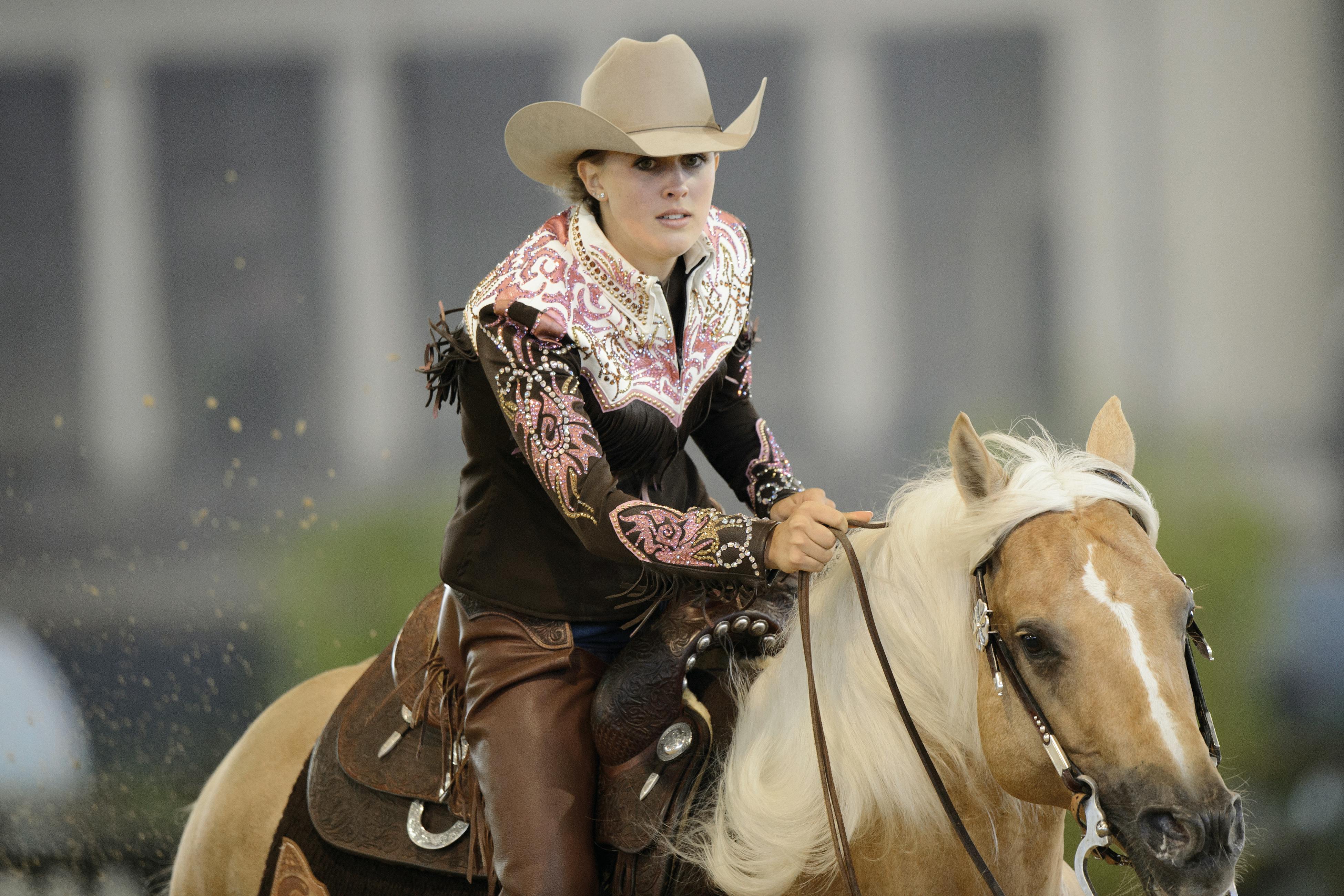This article was produced in association with FEI
“When we talk about Shawn, we think immediately of his incredible unique ability to ride any horse, trained by him or another trainer, and coax out that horse’s performance to its best ability,” explains Bettina de Rham, Reining Director at the sport’s governing body, the Fédération Equestre Internationale (FEI). “He is known to do this on horses young and old, and also in a very short time frame, if necessary. Whilst Shawn may not be a small man, he rides as light as a feather and somehow seems to be able to tap into a horse’s psyche. His talent is recognised in the community and he is known to give horses the confidence to achieve a performance sometimes greater than they are actually capable of.”
If the American Wild West needed a sport to represent it, reining is surely the one. Always dramatic, always entertaining it sees highly skilled riders displaying cowboy-style manoeuvres on horseback in an arena. These manoeuvres range from circles and 360-degree spins to lead changes (changing the horse’s leading legs), rollbacks (180-degree turns) and, what many consider the signature move of the reining horse, sliding stops.
Cowboy history
“Reining is the Wild West – exciting, fast and furious, where riders and horses deliver spectacular, breathtaking performances true to the traditions of cowboy showmanship,” an FEI spokesperson explains. “The combination of tremendous technique and agility is mixed with a hint of nostalgic bravado and laid-back swagger.”
Reining didn’t become an FEI discipline until 2000, but the sport dates back to cattle ranching among pioneers of the American West, when horses and the cowboys who rode them required immense skill to keep their cattle in check. Reining was first officially recognized as a sport in 1949 by the American Quarter Horse Association.
There are now several different levels of international competition, ranging from CRIs (Concours de Reining International) and FEI continental championships, up to the FEI World Championships and the FEI World Equestrian Games™. The nation that stages the most FEI reining competitions is France, followed by Great Britain, Italy, South Africa and Sweden. This year, the major events are the FEI World Equestrian Games™ in Tryon USA, and the FEI Reining European Championships for Young Riders & Juniors in the French city of Lyon.
The sport is fortunate to have a fan base that is growing year on year. According to FEI figures there are 290 million reining fans worldwide, across 15 key international markets. Social media figures show that over a quarter of fans are in the US, followed by 13 per cent in Germany and 11 per cent in the UK. The discipline is most popular amongst the 45 to 54-year-old demographic (31 per cent of fans), followed by 35 to 44-year-olds (22 per cent), 25 to 34-year-olds (19 per cent) and 18 to 24-year-olds (17 per cent). More fans are female than male, with a ratio of 73:27.
“In a relaxed, inviting atmosphere, rural horse lovers, families and friends revel in a revved-up ranch environment unique to this electrifying sport,” the FEI says of reining fans.
De Rham points out what a perfect sport reining is for commercial sponsors. “They can be attracted to this sport for promotional purposes because it is arena-based, so it’s great for advertising with banners on the walls which are highly visible,” she says. “The media love it as it is easy for them to follow, photograph and televise. Most shows now go out on live streaming so the exposure is worldwide. In terms of demographics, the sport attracts a very wide range of ages and incomes. Also, it attracts sports fans not usually drawn to equestrian events as it is so different and gives sponsors a widespread exposure, not just limited to fans of a single equestrian discipline.”
Another key factor of reining is its cowboy image. “This attracts many people from outside of riding,” de Rham adds. “Many sponsors enjoy using this for corporate entertainment.”
Reining is also a wonderful sport for spectators.
De Rham explains how you don’t have to be an expert to appreciate it. “If you want to understand the technical side, you need to know what the penalties and credits are awarded for but, at the end of the day, a horse spinning like a top or galloping to a dramatic sliding stop is just an amazing thing to see. I’ve heard people say it’s like Formula 1 meets ice skating!”
Talking of Formula 1, one of the more famous athletes involved in top-level reining is Gina-Maria Schumacher (pictured), daughter of the Formula 1 legend Michael Schumacher. Now 21, she has been practising the sport for many years, and has already won gold medals at the FEI World Reining Championships Young Riders. She trains at the Schumacher family ranch in Givrins, in Switzerland.

“It takes a lot of training and patience and trust to get a horse to where you can be one with it inside the ring,” she says. “That’s always a challenge. But when it works, it’s the best feeling ever.”
Schumacher agrees that reining makes for a superb sport for both spectators and participants. “I think it’s great for anyone who enjoys horses and competitions,” she says. “The horses are very easy-going. People with hardly any training or riding skills can ride them. Watching [the sport], you understand it quite quickly. It’s fun because there are so many manoeuvres involved. Spectators really have fun watching and cheering.”
De Rham agrees. She points out how easy it is for spectators to join in with the drama of live reining. “The audience can become involved with cheering, clapping and whistling to encourage the riders and show their appreciation. There is often music playing and the atmosphere can quickly become electric.
“This kind of crowd participation is unique in the equestrian world. It is a wonderful thing for the fans to feel that they are part of the performance.”